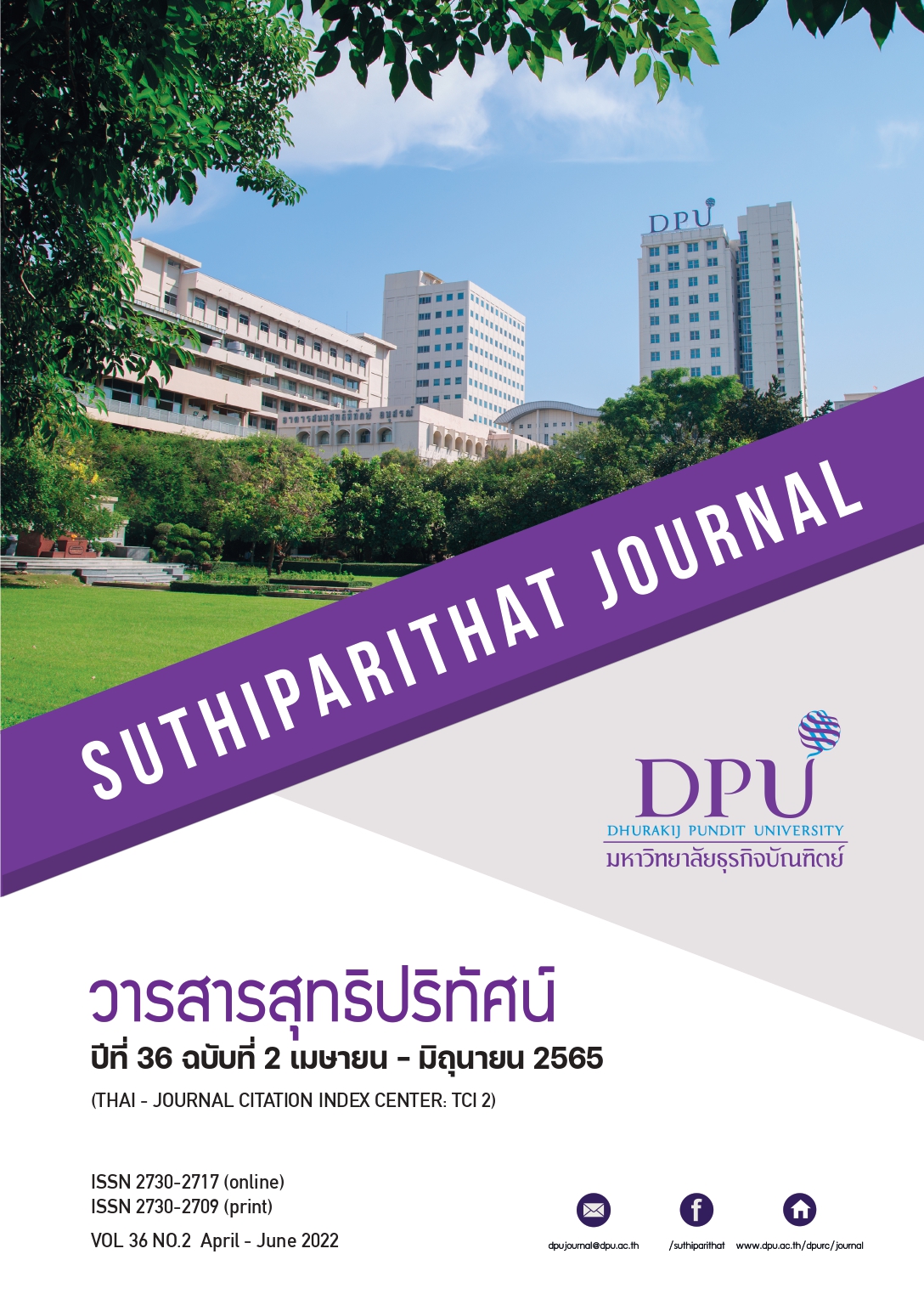การศึกษาเปรียบเทียบช่องว่างคุณภาพการให้บริการของศูนย์กักกันจากความคาดหวังและการรับรู้ของผู้ป่วยในเมืองย่างกุ้ง ประเทศพม่า
คำสำคัญ:
คุณภาพการให้บริการ, ศูนย์กักกัน, ช่องว่างการให้บริการ, ความคาดหวัง, การรับรู้บทคัดย่อ
การศึกษานี้มีวัตถุประสงค์เพื่อตรวจสอบช่องว่างคุณภาพการบริการระหว่างความคาดหวังของผู้ป่วยและการรับรู้ของศูนย์กักกันในย่างกุ้ง สาธารณรัฐแห่งสหภาพเมียนมาร์ และเพื่อศึกษาว่ามิติใดของบริการที่มีอิทธิพลมากที่สุดต่อคุณภาพการบริการที่รับรู้ โดยเน้นที่มิติคุณภาพบริการห้าประการเป็นหลัก ได้แก่ สิ่งที่จับต้องได้ ความน่าเชื่อถือ การตอบสนอง การรับประกัน และความเห็นอกเห็นใจ และเพื่อศึกษาเปรียบเทียบช่องว่างของบริการระหว่างศูนย์กักกันของรัฐและสถานบริการ ประชากรเป้าหมายของการศึกษานี้คือผู้ที่เดินทางกลับจากต่างประเทศมายังเมียนมาร์ในช่วงโควิด-19 ระลอกแรกในปี 2563 การวิจัยเชิงปริมาณดำเนินการเพื่อรวบรวมข้อมูลจากกลุ่มตัวอย่างที่ถูกต้องจำนวน 400 ตัวอย่าง ผ่านทั้งแบบสำรวจออนไลน์และแบบสอบถามที่ใช้กระดาษเป็นหลัก ที่มีประสบการณ์ด้านคุณภาพการบริการจากศูนย์กักกัน
ความน่าเชื่อถือของการศึกษานี้ได้รับการตรวจสอบโดยใช้ค่าครอนบาช อัลฟ่า 0.7 ขึ้นไป การทดสอบ t-test แบบจับคู่ใช้สําหรับการวิเคราะห์ข้อมูลเพื่อทดสอบช่องว่างของบริการระหว่างความคาดหวังและการรับรู้คุณภาพการบริการ ผลการวิจัยพบว่าการรับรู้ของผู้ป่วยในศูนย์กักกันนั้นเกินความคาดหวังทั้งหมด จากผลวิจัยช่องว่างระหว่างความคาดหวังและการรับรู้คุณภาพการบริการของศูนย์กักกันทั้งสองประเภทนั้นเป็นบวกทั้งหมด การรับประกันเป็นองค์ประกอบที่สำคัญที่สุดที่ผู้ป่วยให้คะแนนโดยศูนย์กักกันของภาคเอกชน ในขณะที่องค์ประกอบที่จับต้องได้เป็นมิติที่มีอิทธิพลมากที่สุดสำหรับศูนย์กักกันของรัฐ นอกจากนี้ยังพบว่าคุณภาพการบริการโดยรวมศูนย์กักกันของภาคเอกชนดีกว่าศูนย์กักกันของรัฐมาก จากผลวิจัยข้างต้นการทำวิจัยในอนาคตอาจจะพิจารณาเพิ่มศูนย์กักกันประเภทอื่นๆ ในภูมิภาคทางภูมิศาสตร์ที่แตกต่างกัน
เอกสารอ้างอิง
Andaleeb, S. (1998). Determinants of customer satisfaction with hospitals: A managerial model. Int J Health Care Q Assur, 11, 181-187.
Asubonteng, P., McCleary, K. J., & Swan, J. E. (1996). SERVQUAL revisited: A critical review of service quality. Journal of Services Marketing, 10(6), 62-81. https://doi.org/10.1108/08876049610148602
Bateson, J. E., & Hoffman, K. D. (2011). Services marketing (4th ed.). Boston, MA: Cengage Learning.
Berry, L. L., Parasuraman, A., & Zeithaml, V. A. (1988). The service quality puzzle. Business Horizons, 31(5), 35-43.
Buttle, F. (1996). SERVQUAL: Review, critique, research agenda. European Journal of Marketing, 30(1), 8-32.
Camgöz-Akdag, H., & Zineldin, M. (2010). Quality of health care and patient satisfaction: An exploratory investigation of the 5Qs model at Turkey. Clinical Governance: An International Journal, 15(2), 92-101.
Caruana, A. (2002). Service loyalty: The effects of service quality and the mediating role of customer satisfaction. European Journal of Marketing, 16(7), 811-828.
Chatterjee, S., & Chatterjee, A. (2005). Prioritization of service quality parameters based on ordinal response. Total Quality Management & Business Excellence, 16(4), 477-489.
Cucinotta, D., & Vanelli, M. (2020, March). WHO declares COVID-19 a pandemic. Acta Biomed, 91(1), 157-160. Retrieved from https://pubmed.ncbi.nlm.nih.gov/32191675/
Dagger, T. S., Svveeney, J. C., & Joohnson, L. W. (2007). A hierarchical model of health service quality scale development and investigation of an integrated model. Journal of Service Quality, 10(8), 23-42.
Gronroos, C. (1982). A service quality model and its marketing implications. European Journal of Marketing, 18(4), 36-44.
Gronroos, C. (1994). A service quality model and its marketing implications. European Journal of Marketing, 18(4), 36-44.
Gronroos, C. (1994). From scientific management to service management: A management perspective for the age of service competition. International Journal of Service Industry Management, 15(1), 5-20.
Gronroos, C. S. (1988). The six criteria of good perceived service quality. Rev Bus, 9(3), 10-13.
Hair, J. F., Bush, R. P., & Ortinau, D. J. (2009). Marketing research: In a digital information environment (4th ed.). Boston: McGraw-Hill Irwin.
Hambleton, R. K., & Rovinelli, R. J. (1986). Assessing the dimensionality of a set of test items. Applied Psychological Measurement, 10(3), 287-302. https://doi.org/10.1177/014662168601000307
Kasper, H. V., van Helsdingen, P., & Gabbott, M. (2006). Services marketing management: A strategic perspective (2nd ed.). Chichester, West Sussex, England: John Wiley & Sons.
Kotler, P., Armstrong, G., Saunders, J., & Wong, V. (2002). Principle of marketing (3rd ed.). England: Pearson Education.
Minstry of Health and Sport Myanmar. (2020). Retrieved from https://www.mohs.gov.mm.
Parasuraman, A., Berry, L. L., & Zeithaml, V. A. (1991). Understanding customer expectation of service. Slogan Management Review, 32(3), 39-48.
Parasuraman, A., Berry, L. L., & Zeithaml, V. A. (1933). Research note: More on improving service quality. Journal of Retailing, 69(1), 140-147.
Parasuraman, A., Zeithaml, V. A., & Berry, L. L. (1985). A conceptual model of service quality and its implication for future research. Journal of Marketing, 49(4), 41-50.
Parasuraman, A., Zeithaml, V. A., & Berry, L. L. (1988). Servqual: A multiple-item scale for measuring consumer perception. Journal of Retailing, 64(1), 12.
Ramseook, M., Lukea-Bhiwajee, S., & Naidoo, P. (2010). Service quality in the public service. International Journal of Management and Marketing Research, 3(1), 37-50.
Sower, V. (2011). Essentials of quality. Hoboken. NJ: John Wiley & Sons.
United Nations Office for the Coordination of Humanitarian Affairs. (2020, April 27). IOM Myanmar COVID-19 response situation report, 9 April 2020. Retrieved from https://reliefweb.int/report/myanmar/iom-myanmar-covid-19-response-situation-report-9-april-2020?msclkid=8a3dcf96cef011ecb80244a544cdedb4
World Health Organization. (2020). Coronavirus disease (Covid 19) pandemic. Retrieved from https://www.who.int/emergencies/diseases/novel-coronavirus-2019
Yoon, T. H., & Ekinci, Y. (2003). An examination of the SERVQUAL dimensions using the Guttman Scaling Procedure. Journal of Hospitality & Tourisim Research, 27(1), 3-23.
Zeithaml, V. A., & Bitner, M. J. (2003). Service marketing (3rd ed.). New Delhi: Tata McGraw Hill.
Zineldin, M., Akdag, H. C., & Belal, M. (2012). Total relationship management (TRM) and 5Qs model as new management techniques: A comparative study for a knowledge-intensive sector. International Business and Management, 4(1), 1-17.
ดาวน์โหลด
เผยแพร่แล้ว
รูปแบบการอ้างอิง
ฉบับ
ประเภทบทความ
สัญญาอนุญาต
ลิขสิทธิ์ (c) 2022 มหาวิทยาลัยธุรกิจบัณฑิตย์

อนุญาตภายใต้เงื่อนไข Creative Commons Attribution-NonCommercial-NoDerivatives 4.0 International License.
เนื้อหาและข้อมูลในบทความที่ลงตีพิมพ์ในวารสารสุทธิปริทัศน์ ถือเป็นข้อคิดเห็นและความรับผิดชอบของผู้เขียนบทความโดยตรงซึ่งกองบรรณาธิการวารสาร ไม่จำเป็นต้องเห็นด้วย หรือร่วมรับผิดชอบใด ๆ
บทความ ข้อมูล เนื้อหา รูปภาพ ฯลฯ ที่ได้รับการตีพิมพ์ในวารสารสุทธิปริทัศน์ ถือเป็นลิขสิทธิ์ของวารสารสุทธิปริทัศน์หากบุคคลหรือหน่วยงานใดต้องการนำทั้งหมดหรือส่วนหนึ่งส่วนใดไปเผยแพร่ต่อหรือเพื่อกระทำการใด ๆ จะต้องได้รับอนุญาตเป็นลายลักษณ์อักษรจากวารสารสุทธิปริทัศน์ก่อนเท่านั้น







